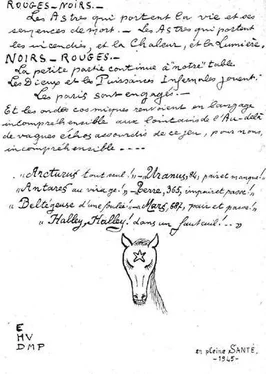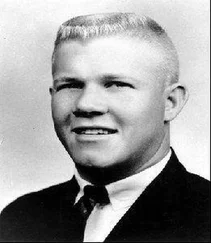As the police stumbled on in the search, appearing no closer to finding Petiot, the bestselling mystery novelist and creator of Inspector Maigret, Georges Simenon, volunteered his detective skills to his old friend Commissaire Massu. The French police certainly looked like they could use the help. Petiot seemed to be taunting them. Was he really the person who sent authorities cryptic notes of his whereabouts or teasing reminders that “Petiot, he runs, he runs, he runs”? Massu certainly thought so.
The international press also seized on the story. In Switzerland, Belgium, and Scandinavia, the Petiot affair dominated headlines on a daily basis. In the issue of March 27, 1944, Time magazine traced the source of the killings to “fatal injections” with the victim “chained to the wall of a soundproof ‘death chamber’ ” and the murderer watching “the last agonies through a peephole.” The report continued:
In the underheated rooms and overcrowded subways, clerks and salesgirls read the gory details. Fleshy black-marketeers and their flashy molls exchanged sadistic tidbits over champagne and caviar
.
The slaughterhouse on rue Le Sueur, Time correctly noted, “crowded war news from headlines.”
Cabaret acts incorporated the grisly material into its shows. “Madame, your bones need some lime” was one example. “ La femme au foyer … ” was another. The story of the “real-life equivalent of Jekyll and Hyde” gave Parisians, in the words of Steward Robertson of the St. Petersburg Times , “a thrill, running second only to the feats of Allied bombers.” No one yet knew the scale of the crimes, but Paris seemed obsessed with Petiot Mania. “Will Dr. Petiot be found?” Paris-Soir asked on March 18, 1944, only to answer that it was doubtful.
“WHO would have believed that this is possible,” the concierge at 66 rue Caumartin, Raymonde Denis, told Massu when he and one of his officers returned to the suspect’s apartment. Petiot, she said, “was so nice, so sweet”—he was one of her kindest tenants. She was still in disbelief. Massu muttered something polite about how it is possible to rub shoulders with someone for years without ever realizing that that person conceals dark secrets, but the concierge stuck to her opinion of the alleged killer.
Not far away, at 17 rue Darcet, the location of a bistro that had until recently been run by Petiot’s patients and friends Louis Albert and Emilie-Justine Bézayrie, Inspector Battut questioned someone who might have seen the murder suspect on the night of the discovery. The new bistro manager, Maria Vic, said that a man had come into her establishment about nine fifteen or nine twenty p.m. and asked to use the telephone. When she agreed, he told her the call was to the region of Yonne. She was not sure who he was, whom he called, or what they discussed. She went to wash the dishes. At some point, she thought she heard the words “Burn the papers!”
Was this perhaps the call that Maurice admitted receiving? Massu put a trace on it, and by the end of March, he would have confirmation that the call from the Parisian bistro had in fact been to Maurice Petiot. Vic stood by her statement that the man who borrowed the telephone was Dr. Petiot.
Detectives now wanted to speak with the previous owners of the establishment, Louis and Emilie Bézayrie, who had operated the bistro from 1935 to December 1943, when they moved to a new location, on rue de la Jonquière in the 17th arrondissement.
Louis Bézayrie had known Petiot since September or October 1940. His wife Emilie was then pregnant, and as her doctor had been taken prisoner by the Germans, she had consulted Petiot on a recommendation from a friend. He had assisted at the birth of their son, and, as the baby was often sick, she continued to see him regularly. Petiot also was a customer at the bistro, sometimes buying coal in bulk (many bistros during the Occupation supplemented their income by selling coal). Bézayrie had not seen him for some time, he said, and he had not sold him coal since September 1942, when he arrived with his cart and purchased about three hundred kilos.
The owners of the café had more information for the detectives. In fact, Louis Bézayrie would provide a lead that might well have resulted in an early apprehension of the suspect, had investigators pursued it. He suggested that the detectives question “old man Redouté,” a housepainter in his mid-fifties who often shared a drink with the physician. The French police later defended this failure to investigate on the extraordinary grounds that they believed Redouté was the man’s first name and could not locate him.
Petiot had indeed been hiding with Georges Redouté in his small apartment at 83 rue du Faubourg Saint-Denis. The exact date of his arrival was never determined, but it was early in the manhunt. Redouté would later claim that it was March 25, 1944; Petiot would say it was the twelfth or thirteenth. The police would never clarify his first movements before he arrived at Redouté’s apartment, suitcases in hand, claiming to be a member of the Resistance on the run from the Gestapo.
Redouté, of course, knew about the murder allegations, as they had been plastered in every Parisian newspaper. But he believed Petiot’s tales of fighting the Germans and agreed to allow him to stay in his apartment. The murder suspect slept on a mattress on the floor of Redouté’s dining room.
During the day, Petiot tended to remain inside reading newspapers, working crossword puzzles, and listening to clandestine BBC radio broadcasts. He continued to devour police novels, and created special dice for making a range of probability calculations, something that would soon absorb his attention. Generally he refused to let anyone inside the apartment. The concierge, Henriette Kraeber, later recalled the difficulty of convincing him that a man sent around to fix a leak was actually a plumber. Redouté’s guest, she said, “only went out for food and books.” Petiot, “a convincing talker,” would spend many evenings regaling his host with stories of his alleged Resistance activities.
He was also growing a beard and often wearing dark glasses to disguise his profile, raising the question of whether the L’Oeuvre journalist who believed he had seen Petiot on a Parisian métro quay in late March had not in fact come across the suspect.

AFTER hours of searching rue Le Sueur or reading police reports, Massu would often enjoy a brisk walk, even if it was only to a nearby bistro. Along the way, he tried to imagine how Petiot murdered his victims, disposed of the bodies, and evaded detection for so long in the middle of Paris. He started thinking of various possible poisons. If only, he mused, the people he passed by at the secondhand bookstalls on the quays could read his thoughts.
For a homicide detective, however, Massu believed that “a single small piece of uncovered evidence is better than a thousand ideas,” and he would often simply leave his office with the urge to visit the site, or, as he put it, “speak to the walls.” On the way there, he frequently encountered sightseers pleading to be shown inside the town house. Most of them, he believed, would probably pass out after five minutes.
His son, Bernard, would continue to follow him to the crime scene. “He had youth, I had experience,” the commissaire said, and the clash of the two perspectives would often lead to valuable results. Bernard had another quality that his father admired: When it came to finding answers, he was as “impatient as a young dog.” All of this would be crucial to the task of reconstructing the ways the killer lured victims to the house for a horrific odyssey that somehow involved the triangular room, the dissection table, the basement furnace, and the lime pit.
Читать дальше













